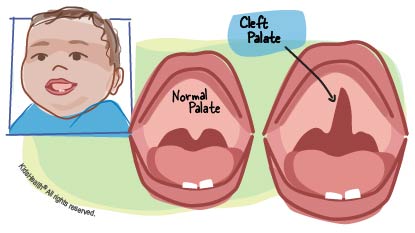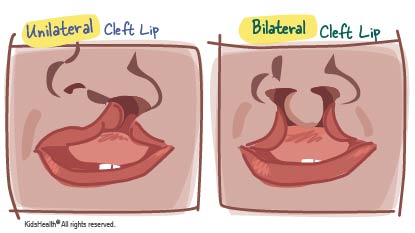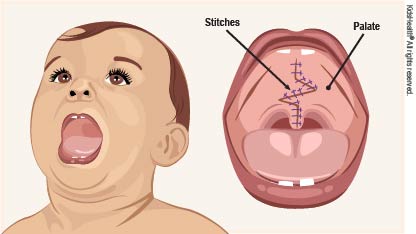Cleft Palate With Cleft Lip
What Is Cleft Lip and Palate?
A cleft of the lip or palate happens when a baby is born with an opening in the upper lip or the roof of the mouth (the palate). These orofacial clefts are some of the most common birth defects.
A baby with a cleft might have:
- only a cleft palate
- only a cleft lip
- both a cleft lip and a cleft palate
A cleft palate (PAL-it) is when a baby is born with an opening (a cleft) in the roof of the mouth. This leaves a hole between the nose and the mouth.
The opening can:
- just be in the back of the palate (the soft palate)
or - extend into the front of the palate behind the gums (the hard palate)

Babies who are born with cleft lip have a gap or opening in the upper lip. This happens when the baby's lip doesn't form properly early in pregnancy, resulting in a split.
A cleft lip can be:
- on one side of the lip (a unilateral cleft lip). This type is more common.
- on both sides of the lip (a bilateral cleft lip)

Clefts can range in size:
- Some are just a small notch in the lip (an incomplete cleft lip).
- Others extend completely through the upper lip and gum into the nostril (a complete cleft lip).
If the opening in the palate connects with the opening in the gums and the lip, a baby has cleft lip and palate.
What Causes Cleft Lip and Palate?
During the first 6 to 10 weeks of pregnancy, the bones and skin of a baby's upper jaw, nose, and mouth normally come together (fuse) to form the roof of the mouth and the upper lip. A cleft happens when parts of the lip and/or palate do not fuse together completely.
Doctors don't always know why a baby develops a cleft, though some may be related to genetic (inherited) factors. Also, some environmental factors can increase the risk of a birth defect, such as:
- taking certain medicines (such as some anti-seizure medicines) during pregnancy
- not getting the right amount of prenatal nutrients, such as folate
- exposure to some chemicals during pregnancy
- smoking cigarettes, using drugs, and/or drinking alcohol during pregnancy
How Is a Cleft Lip and Palate Diagnosed?
Usually, clefts are found when a baby is born. Sometimes, they're seen before a baby is born on a prenatal ultrasound. Without a cleft lip, a cleft palate is harder to see on ultrasound. Doctors usually find a cleft palate when they look and feel inside a baby's mouth during the first newborn exam.
How Is Cleft Palate With Cleft Lip Treated?
Cleft lip and cleft palate can cause problems with:
- feeding
- growth and development
- ear infections and hearing
- speech development
It's important to correct a cleft palate with cleft lip with surgery while a child is young.
Cleft Lip Repair
A plastic surgeon will repair the baby's cleft lip first, usually when the baby is about 3 months old. This is done with a surgery called cheiloplasty (KY-lo-plass-tee). It's done in the hospital while the baby is under general anesthesia.
The goals of cleft lip repair are to:
- Close the cleft.
- Improve the shape and symmetry of the upper lip and nose.
If the cleft lip is wide, special procedures like lip adhesion or nasal alveolar molding (NAM) might help bring the parts of the lip closer together and improve the shape of the nose before the cleft lip repair. Cleft lip repair leaves a small scar under the nose in place of the cleft.
Cleft Palate Repair
A cleft palate usually is repaired with surgery called palatoplasty (PAL-eh-tuh-plass-tee) when the baby is 10–12 months old. The goals of palatoplasty are to:
- Close the opening between the nose and mouth.
- Help create a palate that works well for speech.
- Prevent food and liquid from leaking out of the nose.
In palate repair surgery, the surgeon will:
- Rearrange and repair the muscles of the soft palate so they work better during speech.
- Close the cleft in layers.
The surgeon may need to make two incisions (cuts) on each side of the palate behind the gums to ease tension on the palate repair. These are called “relaxing incisions.” In some cases, the surgeon may also borrow some tissue from the inner surface of the cheeks to help complete the repair.
Cleft palate repair requires general anesthesia and takes about 2–3 hours. Most babies can go home after 1 or 2 days in the hospital. The stitches will dissolve on their own.
Your child will need a liquid or blenderized (puréed) diet for about 3 weeks after surgery before starting to eat foods that are hard or crunchy. You may be asked to keep your baby in special sleeves ("no-nos") that prevent the elbows from bending. This is so your baby can't put any fingers or hard objects into the mouth, which could make the cleft palate repair come open.

When Should I Call the Doctor?
Cleft lip and palate surgeries have greatly improved in recent years. Most kids who undergo them have very good results. There are risks with any surgery, though, so call the doctor if your child:
- has a fever above 101.4°F (38.5°C)
- has lasting pain or discomfort
- has heavy bleeding from the mouth or nose
- won't drink fluids
- isn't making wet diapers
What Else Should I Know?
A child with a cleft lip and palate can sometimes have other health problems, such as:
- fluid buildup behind the ear
- trouble feeding
- hearing loss
- dental problems
- speech problems
It's important to work with a care team experienced in treating children with cleft lip and palate. Besides the pediatrician, a child's treatment team will include:
- a patient care coordinator
- cleft surgeon (pediatric plastic surgeon or oromaxillofacial surgeon with cleft care experience)
- ear, nose, and throat (ENT) surgeon (otolaryngologist)
- orthodontist
- speech-language pathologist
- audiologist
You might also work with:
Some kids with cleft lip and palate may need other surgeries as they get older. These might include:
- Speech surgery: Children can develop speech problems even after the palate has been repaired. At your regular appointments with the cleft team, the speech-language pathologist will carefully listen to your child's speech to help the surgeon decide if another surgery is needed to improve nasal sounding speech, or “VPD.”
- Alveolar (al-VEE-eh-lur) bone grafting: Doctors might use a small amount of bone from the hip to repair the cleft or notch in the gums and to support the permanent teeth as they come in. This surgery is usually done when kids are 7–9 years old.
- Nose surgery: Clefts of the lip also affect how the nose looks, so some kids may benefit from more surgery on the nose. Fixing minor problems, such as the shape of the nostrils, can be done during childhood. More extensive nose surgeries, if needed, are done when the child is finished growing.
- Orthognathic (or-thig-NATH-ik) surgery: Some children with cleft palate need this surgery to realign the jaws and teeth when they're older. It's done when the child is finished growing.
Looking Ahead
Most kids with cleft lip and palate are treated successfully with no lasting problems. A team experienced in treating children with cleft lip and palate can create a treatment plan tailored to your child's needs.
The psychologists and social workers on the treatment team are there for you and your child. Turn to them to help guide you through any hard times. You also can find more information and support online:
